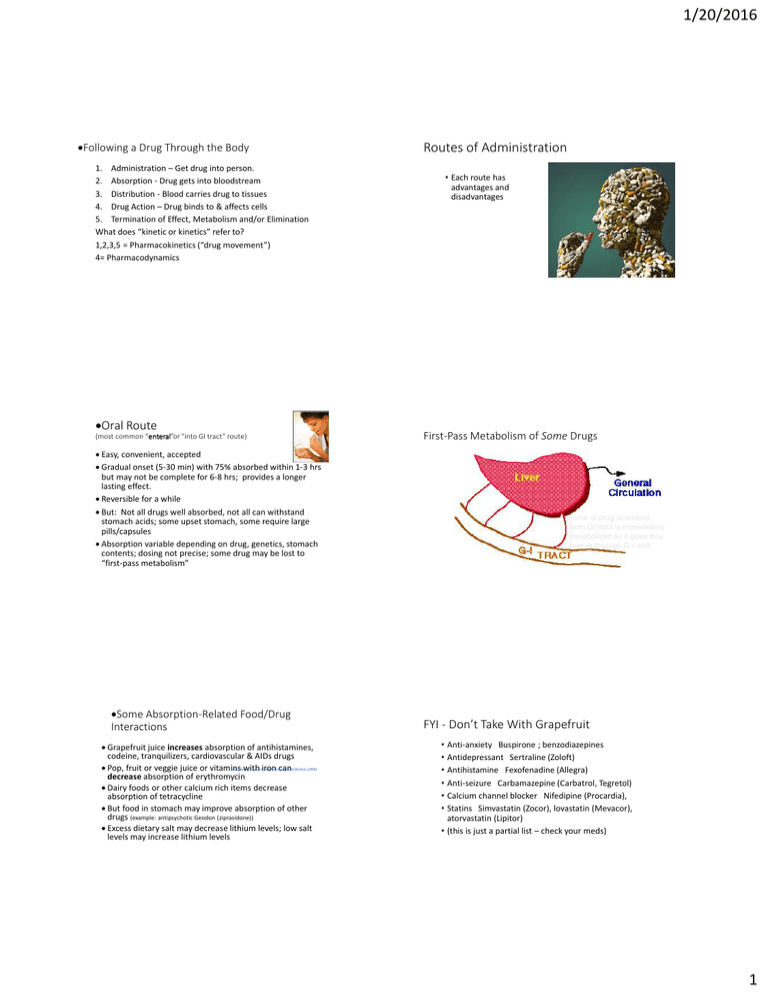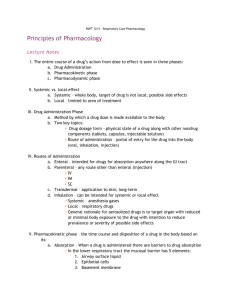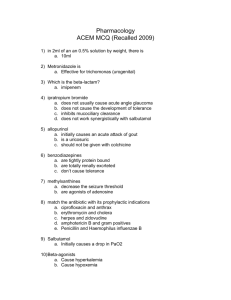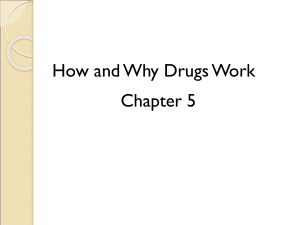1/20/2016 Routes of Administration Following a Drug Through the Body
advertisement

1/20/2016 Following a Drug Through the Body 1. Administration – Get drug into person. 2. Absorption - Drug gets into bloodstream 3. Distribution - Blood carries drug to tissues 4. Drug Action – Drug binds to & affects cells 5. Termination of Effect, Metabolism and/or Elimination What does “kinetic or kinetics” refer to? 1,2,3,5 = Pharmacokinetics (“drug movement”) 4= Pharmacodynamics Oral Route (most common “enteral”or “into GI tract” route) Easy, convenient, accepted Gradual onset (5-30 min) with 75% absorbed within 1-3 hrs but may not be complete for 6-8 hrs; provides a longer lasting effect. Reversible for a while But: Not all drugs well absorbed, not all can withstand stomach acids; some upset stomach, some require large pills/capsules Absorption variable depending on drug, genetics, stomach contents; dosing not precise; some drug may be lost to “first-pass metabolism” Some Absorption-Related Food/Drug Interactions Grapefruit juice increases absorption of antihistamines, codeine, tranquilizers, cardiovascular & AIDs drugs Pop, fruit or veggie juice or vitamins with iron can decrease absorption of erythromycin Dairy foods or other calcium rich items decrease absorption of tetracycline But food in stomach may improve absorption of other drugs (example: antipsychotic Geodon (ziprasidone)) Excess dietary salt may decrease lithium levels; low salt levels may increase lithium levels http://www.cmaj.ca/content/early/2012/11/26/cmaj.120951 Routes of Administration • Each route has advantages and disadvantages First-Pass Metabolism of Some Drugs Some of drug absorbed from GI tract is immediately metabolized as it goes thru liver or through G-I wall FYI - Don’t Take With Grapefruit • Anti-anxiety Buspirone ; benzodiazepines • Antidepressant Sertraline (Zoloft) • Antihistamine Fexofenadine (Allegra) • Anti-seizure Carbamazepine (Carbatrol, Tegretol) • Calcium channel blocker Nifedipine (Procardia), • Statins Simvastatin (Zocor), lovastatin (Mevacor), atorvastatin (Lipitor) • (this is just a partial list – check your meds) 1 1/20/2016 Something New: “Prodrugs” Effect of Grapefruit on BuSpar Absorption J Just an example of how the grapefruit juice effect could put you in an overdose situation even though you took your normal dose • May orally administer a “prodrug” (something that will be turned into an active drug in your stomach but won’t be active otherwise) • Example: Vyvanse for ADHD • Lysine attached to d-amphetamine makes it inactive until the lysine is removed in stomach. The d-amphetamine won’t be active if snorted or ground up and injected. Figure 2.3 Claire D. Advokat, Joseph E. Comaty, Robert M. Julien: Julien’s Primer of Drug Action, Thirteenth Edition Copyright © 2014 by Worth Publishers Inhalation Injection (see Table 1.1 on p 12) Subcutaneous (SC) or “skin-popping” Inhalation of gases/vapors and/or particles Rapid absorption in lungs & fastest route to brain (5-8 seconds) Fairly easy once learned But: Many drugs cannot be inhaled Dose can be difficult to control There is no drug depot or reserve Inhalation via smoking presents special risks. IV Injection or Infusion Intravenous (IV) Fast (~ 15 seconds to brain) Bypasses absorption obstacles Most difficult & risky route All injection routes give good control of dose Implanted medication port for IV access Slowest injection route; can irritate skin Often used for insulin injections http://www.cc.nih.gov/ccc/patient_education/ pepubs/subq.pdf book error? Intramuscular (IM) Intermediate speed depending on muscle selected (arm faster than butt) & vehicle (oil or micro-encapulated injections in butt, e.g. “depot” injections of antipsychotics, or long-acting naltrexone for recovering addicts, absorbed over weeks) Easier to do than intravenous Injection Problems • Intravenous route most dangerous because of risk of possible life-threatening reactions or allergic responses • Risk of clots or emboli due to particles, air bubbles • Must use sterile procedures or risk infection. • Site of injection deteriorates with repeated injections. • Not reversible 2 1/20/2016 Through Mucous Membranes (see more examples p 10) Sublingual Sublingual (under tongue)- nitroglycerine; Suboxone Buccal (held in cheek) - Nicorette gum, fentanyl Intranasal (sprays or snorting) Narcotic ‘lollipop’ for kids Nitroglycerin for fast relief of angina pain Intranasal Suboxone for recovering narcotic addicts (buprenorphine + naloxone) Others Imitrex Nasal Spray for Migraines • Decongestant Spray Topical – applied to skin Transdermal (see p.38 examples) high tech continuous, controlled release of a steady dose of drug Rectal- another “enteral” route (suppository or enema) Implantable (Implanon birth control) http://news.yale.edu/2013/12/02/single-spray-oxytocin-improves-brain-functionchildren-autism Transdermals New 3 Day Insulin Patch Nitroglycerin for Angina Contraceptive Patch Scopolamine motion sickness patch Fentanyl for pain for depression New long-acting patches for migraine, antipsychotics and Parkinson’s disease meds are being tested for commercial release 3 1/20/2016 Drug Implants New Implanon implanted Contraceptive (single progestin rod) Implanted pump to relieve chronic pain Routes Vary in: Form of drug Dose necessary & absorption Time course (start & length of effect) Intensity of drug effects- inhalation & intravenous most intense Risks & benefits Other implants under development: e.g. antipsychotic implant Route-Related Differences in Drug Time Course Following a Drug Through the Body 1. 2. 3. 4. 5. Distribution Bloodstream distributes drug widely (not just to the problem area) Drugs vary in how fast they leave blood (depends on concentration, fat-solubility of drug & whether it binds to proteins in blood) Presence of other drugs can alter this speed – this is one source of drug-drug interactions (you may skip p 42-43) Administration – Get drug into person. Absorption - Drug gets into bloodstream Distribution - Blood carries drug to tissues Drug Action - Drug interacts with cells Termination of Effect, Metabolism and/or Elimination Study of 1,2,3, & 5= pharmacokinetics Study of action = pharmacodynamics Limitations to Distribution: the “blood-brain barrier” excludes or slows entry of many drugs into brain. (Psychoactive drugs are the fat-soluble ones that do make it into brain.) the “placental barrier” excludes some large molecule chemicals but does NOT exclude psychoactive drugs. 4 1/20/2016 Following a Drug Through the Body 1. Administration – Get drug into person. 2. Absorption - Drug gets into bloodstream 3. Distribution - Blood carries drug to tissues 4. Drug Action – Drug binds to & affects cells 5. Termination of Effect, Metabolism and/or Elimination What does “kinetic or kinetics” refer to? 1,2,3,5 = Pharmacokinetics (“drug movement”) 4= Pharmacodynamics Why Drug Effects End Why Do Drug Effects End? Meet the Families *Drug may be “biotransformed” or metabolized by liver, then excreted by kidney. Drug may be excreted by kidney unchanged. Some drugs may leave in feces or other bodily fluids (milk, sweat, breath) Some molecules may be broken down at site of action (e.g. receptor sites in CNS) or before they are even absorbed Drug effect may end because the drug moves away from the site of action (e.g. from brain to body fat) Cytochrome P450 (CYP) Enzymes • Families of enzymes found in liver & GI tract lining • Metabolize or break down lots of chemicals • Different subfamilies handle different drugs CYP Families of Enzymes • Affecting these enzymes will affect drug metabolism • “Grapefruit juice effect” – blocks CYPs in GI tract so LESS drug metabolized & more gets into bloodstream • Some drugs increase these enzymes (e.g. Tegretol) so drugs get metabolized FASTER • Others drugs decrease these enzymes (e.g. Prozac can decrease metabolism of Clozaril; valproate inhibits metabolism of Lamictal) • CYP effects are the reason behind lots of drug-drug interactions and some may be serious or even fatal 5 1/20/2016 People Differ in How Much & What Forms of CYP Enzymes They Have (p.53) • Example: A study of 1199 psychiatric patients • These diffs may be a major reason for individual differences in drug response, side effects, & risks • DNA tests can now determine if you are a normal, slow or fast metabolizer of certain drug categories. • “Pharmacogenetics” is a growing area of drug research. Figure 2.13 Claire D. Advokat, Joseph E. Comaty, Robert M. Julien: Julien’s Primer of Drug Action, Thirteenth Edition Table 2.2 Claire D. Advokat, Joseph E. Comaty, Robert M. Julien: Julien’s Primer of Drug Action, Thirteenth Edition Copyright © 2014 by Worth Publishers Copyright © 2014 by Worth Publishers P 52 The “Half-Life” of a Drug: • The rate of metabolism of most drugs varies with the concentration of drug in the body: • more metabolized/hr when concentration is high • less metabolized/hr as the concentration drops The time it takes for half the available drug to be eliminated from the body, as measured by a 50% drop in blood levels. With each successive half-life another 50% of the remaining drug in the blood will be eliminated Knowing half-life is important for understanding time course of drug and how often to administer it. A drug’s effects may be longer and more intense if liver and/or kidney are not functioning up to par. Example: Caffeine • Drank 8 oz. Starbucks coffee containing 250 mg caffeine at 7 PM • Caffeine half-life “on average”: ~5 hrs • Midnite – 125 mg left in your body • 5 am 62.5 mg left in body • 10 am 31.25 mg left in body • 3 PM 15.6 mg left in body • 8 PM 7.8 mg • 1 AM 3.9 mg (98.4% has been eliminated after 6 half-lifes – almost drug-free) Table 2.4 Claire D. Advokat, Joseph E. Comaty, Robert M. Julien: Julien’s Primer of Drug Action, Thirteenth Edition Copyright © 2014 by Worth Publishers 6 1/20/2016 Sample Average Half-Lives Pharmacokinetic Differences (Absorption, Metabolism) Cause Drug Time Course Diffs (p. 33) (Halcion) Aspirin .5-1.5 hrs Morphine 1.5-2.5 hrs Tetracycline 2.5-5.5 hrs Haldol 6-18 hrs Lithium 18-30 hrs Valium ~30 hrs in young, • several days in elderly (Ativan) Notice ranges: Figure 2.2 Claire D. Advokat, Joseph E. Comaty, Robert M. Julien: Julien’s Primer of Drug Action, Thirteenth Edition Copyright © 2014 by Worth Publishers An Exception to the Rule • Alcohol is metabolized at a steady rate, regardless of the concentration of the drug in the body. • On AVERAGE the liver metabolizes slightly less than 1 STANDARD drink per hour, whether you have 1 drink in your body or 20. • Elimination of drug from the body relates not only to the length of the drug effect but also the detection of the drug by a drug test. Average Detection Time in Days • Alcohol • Amphetamine • Benzodiazepine • Cocaine • Marijuana • Opiate • Phencyclidine up to 1 1-4 7-42 1-3; up to 12 for chronic use 1-7; up to 35 for chronic use 1-3 2-7; up to 30 for chronic Dose and Its Relationship to Drug Effects (covered in Chap 3 starting p 78) Think about your prescription & OTC medications. How is the dose usually expressed? 7 1/20/2016 Dose What’s the Right Dose for Me? Most drugs have doses expressed in milligrams (mg.) (thousandths of a gram) e.g. 200 mg tablet of ibuprofen Exceptions: LSD (50-150 micrograms (millionths)); fentanyl – a fraction of a milligram (.05 mg-.10mg) A rule to remember: Wide individual variability in drug response We differ in absorption, distribution, drug action, and/or metabolism/elimination. For example, remember our question of how much you have to drink before you just start to feel the alcohol? What Dose Will Produce the Desired Effect in Different People? 50 ED50 Individual differences is the rule even when we have already adjusted for weight 40 If you are a drinker, imagine that you go out drinking (on an empty stomach). How much or how many of the standard drinks above would you have to drink to JUST START FEELING the ALCOHOL? A swallow? ¼ of a beer? ½? 1 can? 1½ cans? 2 cans? 2 ½? 3? # of Subjects 30 20 10 0 1 3 5 7 9 11 Dose (mg./kg.) 13 15 The Dose-Response Curve • So what dose should the manufacturer sell or recommend on the package? • Most often choose the “average dose” or ED50 – a dose which will be effective for 50% of the people (even though some actually needed less and some need more) Graphic representation relating the amount of drug administered to the response produced Response may be represented as intensity of response OR as % of group responding at each dose Curve is for a particular drug effect only Different effects of a drug may show different doseresponse relationships. All drugs have multiple effects. 8 1/20/2016 Another Way to Show a Dose-Response Relationship: % Who Get Desired Response at Each Dose - Remember: curve is for a specific effect of the drug. Other effects of drug may require different dosages. (dangerous) Every Drug Produces Multiple Effects Sleep Notice in this example the curve for the desired effect overlaps the curve Safety Margin LD1/ED99 = 180/275for or the lethal dose .65 (<1 means someone’s LD is lower than some people’s ED) A Safer Drug: Therapeutic vs. Toxic Effects Measures of a Drug’s Safety • Therapeutic Index compares the average LD to the average ED (LD50/ED50) • LD50/ED50 (based on animal research) 100 Therapeutic 80 % Responding Lethal • THC TI=1000 Valium TI=100 • Morphine TI=70 Alcohol TI = 10 • Digoxin TI = 2 Lithium TI= 1.8 60 40 ED99 20 LD50 LD1 ED50 • More conservative “Safety Margin” LD1/ED99 Compares the lowest LD to the highest ED likely to be used 0 70 80 90100 200 300 Dose 9 1/20/2016 Potency vs Effectiveness Potency – related to the dose of drug required to produce a particular effect Efficacy or Effectiveness – related to the maximum possible effect obtainable from a particular drug Does this mean alprazolam is better?? Sample Contents of Some Coated Tablets: Potency Differences 5 mg active drug 30 mg sugars 6 mg cornstarch 9 mg miscellaneous 10 mg coating With many of today’s drugs potency is not an important feature – drugs are already so potent that they have to add filler to make the pill large enough to handle. Dose-Response Curves Showing Difference in Potency Both drugs can produce the effect but need higher dose of lower potency drug Dose Dose-Response Curves Showing Difference in Efficacy & Potency A POTENCY Difference Same max effect An EFFICACY Diff Diff max effects A POTENCY Diff Same max effect 10 1/20/2016 Comparing Curves Side-Effects of Drugs Say it with me: All drugs produce multiple effects! “Side-effects” are the effects not sought by the user. One person’s desired effect may be another person’s “side effect”. Every drug has some side-effects that are quite common & others that occur more rarely. Side effects may be mild, disturbing or even dangerous. Potentially serious side-effects are often called “adverse reactions”. Each year over 100,000 die from adverse reactions to properly prescribed drugs. Some Adverse Reactions: Hypersensitivity An allergic response to a drug, usually (but not always) after the person has become sensitized to it. May cause rash, swelling, fever, or, in the worst cases, anaphylactic shock. Anaphylaxis is a life-threatening medical emergency. Signs of anaphylaxis: tingling lips and mouth flushing of face, body itchy eyes, nose, face hives eyes and face swelling wheezing Symptoms rapidly progress to: weakness,dizziness throat swelling closed low blood pressure cardiac arrhythmia loss of consciousness possible death http://www.youtube.com/watch?v=TTcL7u05aUU Some Adverse Reactions: Idiosyncratic Response Rare, unpredictable, highly individual response to a drug. The user may be at the extremes of the dose-response curve or may exhibit unusual physiological or behavioral responses to the drug. Some U.S. Statistics • 106,000 known deaths/yr due to adverse reactions to properly used drugs • 3-4% of hospitalizations lead to adverse reactions • 7,000 additional known deaths due to medication errors • Don’t know the # of non-fatal problems. 11 1/20/2016 You’ve taken this dose of this drug before, but this time you don’t experience the same degree of effect. Why? Tolerance Tolerance: progressively decreasing drug effects due to regular, repeated administration. Some tolerance may begin to develop within a single episode of use (acute tolerance), but tolerance from regular use (protracted tolerance) is even more significant To experience the original degree of drug response the individual must increase their dose. Mechanisms by Which Tolerance Occurs: But: All effects of a drug may not show equal degrees of tolerance. And, under certain conditions, we might experience reverse tolerance or sensitization – an increased (sometimes dangerous) response after repeated use Metabolic tolerance (increased liver metabolism of drug) Pharmacodynamic, cellular adaptive or “tissue tolerance” (cells at drug’s site of action adapt to the drug) Behavioral or conditioned tolerance (learning/conditioning leads to decreased drug effects) Example of Conditioned Tolerance Group A & Group B rats receive same dose of drug for 10 days. Group A always gets drug in the same setting while Group B gets the drug in a new and different setting each day. After 10 days Group A shows more tolerance/less drug response. The setting cues trigger learned counterreactions that decrease the effects of the drug • Rats with tolerance were more likely to survive the usual LD100 • Only 32% died if tested in the setting where they usually received injections • 64% died if tested in a situation not previously associated with drug administration 12 1/20/2016 Physical Dependence: Body physically adapts to, & (to a certain extent) compensates for the regular presence of the drug. Evidence that this adaptation/compensation has occurred: User experiences withdrawal symptoms or “abstinence syndrome” if drug is not administered. Most withdrawal symptoms are the opposite of the drug effect. Cross-Tolerance & Cross-Dependence Tolerance to a drug often extends to other (usually chemically related) drugs. When physical dependence occurs, other chemicallyrelated drugs can “satisfy” that dependency & prevent withdrawal. May Be Due to Drug Interactions Drug Interactions: Having more than 1 drug in your body can change the experienced effects The presence of another drug may alter absorption, distribution, metabolism, elimination, and/or receptor interactions. Example: Heroin (just read lists) • USING • Euphoria • Sedation, sleep • Constipation • Analgesia • Pupil constriction • Decreased respiration, HR, BP • WITHDRAWING • Dysphoria • Insomnia • Explosive diarrhea • Pain • Pupil dilation • Increased HR, BP, breathing You’ve taken this dose of this drug before, but this time you don’t experience the same degree of effect. Why? Some interaction examples: Additive (1+1=2) - Effects of 2 analgesics in Excedrin add together Synergistic (1+1=3) - Taking alcohol + another depressant can lead to more than the sum of their effects (synergism) Potentiating (0+1=2) - Tagamet, Zantac, birth control pills, or erythromycin can potentiate sedative effects of benzodiazepines like Xanax Antagonistic - Smoking can decrease the effectiveness of a wide range of medications Altered Side Effects - Taking alcohol and aspirin increases stomach upset http://www.drugs.com/drug_interactions.php 13



